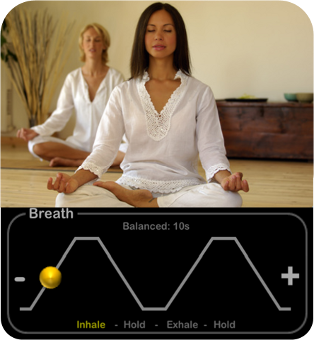
The Power of the Coherence
Yogis knew this for a long time but they probably did not know why:
Here is why
Your Heart Rate Continuously Changes While
You are Breathing
Not everybody know there is a strong relationship between the heart rate and the diaphragmatic breathing phases (inhaling and exhaling). Well-known in the medical field as Respiratory Sinus Arrhythmia (RSA), this physiological phenomenon can be explained, in brief, as follows:
 During the inhalation phase, the diaphragm descends to create a depression within the chest. This depression recalls the air to flow into the lungs. By contrast, during the exhalation phase, the diaphragm causes an increase of pressure within the chest. This causes the lungs to expel the air.
During the inhalation phase, the diaphragm descends to create a depression within the chest. This depression recalls the air to flow into the lungs. By contrast, during the exhalation phase, the diaphragm causes an increase of pressure within the chest. This causes the lungs to expel the air.
The pressure variation within the chest is also detected by the baroreceptors, which are responsible for the blood pressure control. The baroreceptors inform the Central Nervous System (CNS) about the detected pressure variation.
When the CNS is informed about a decrease of pressure,
it increases the heart rate to compensate for the pressure decrease. By contrast, when the CNS is informed about a pressure increase, it decreases the heart rate.
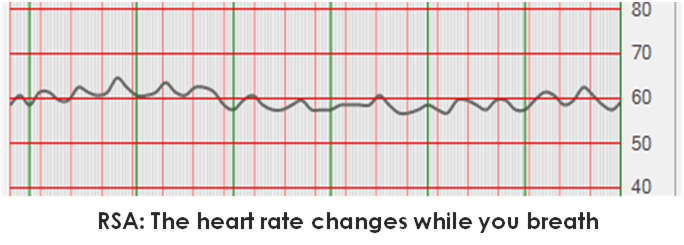 Therefore we have an increment of the heart rate during inhale, and a decrement of the heart rate during exhale. This heart rate variation, caused by breathing, is named: RSA.
Therefore we have an increment of the heart rate during inhale, and a decrement of the heart rate during exhale. This heart rate variation, caused by breathing, is named: RSA.
Is it Good Having a Continuous Heart Rate Variation?
The consequence of the RSA is that the heart rate continuously varies. What is normally shown by heart rate detectors, like sport belts, is an average value of the heart rate, but not the real time value which changes at every heart pulse.
The continuous change of the heart rate can be observed and measured into a parameter called Heart Rate Variability (HRV). Studies demonstrate that the highest value of the HRV is associated with a healthy heart and nervous system. Conversely, a low HRV might indicate problems with the heart and/or nervous system. Reduced HRV has been shown to be a predictor of
mortality after myocardial infarction[1][2] . A range of other outcomes/conditions may also be associated with modified (usually lower) HRV, including congestive heart failure, diabetic neuropathy, depression, post-cardiac transplant, susceptibility to SIDS and poor survival in premature babies.
In particular, a correlation has been found between HRV and age [3]. Younger people have a higher HRV, while older people have a lower HRV.
As a rule of thumb, a higher HRV value is normally better than a lower HRV value, but to know what is good for you, we recommend getting medical advice.
Increase the Heart Rate Variability with Breathing Exercises
The HRV is something which can be trained and increased. But how? We have seen that breathing acts cause heart rate variation. Therefore breathing exercises are a good way to obtain the result. But you need to know which kind of breathing pattern and breathing cycle duration to use to get the result. Let's find out.
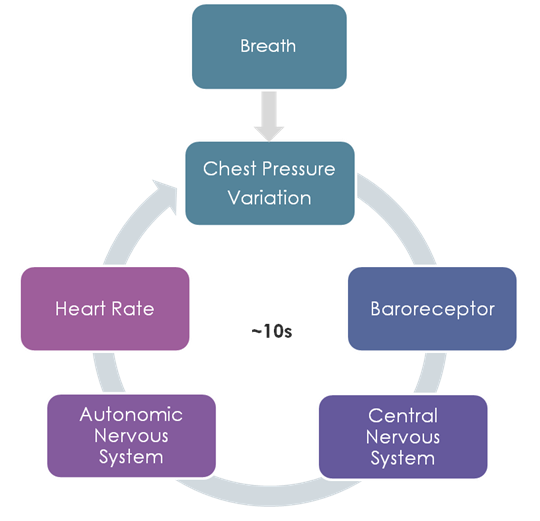 When discussing about the RSA,
we have seen there is a mechanism controlling the blood pressure by means of accelerating and decelerating the heart rate. This mechanism works in a loop, which tends to maintain a constant blood pressure level. The loop can be described with the following example:
When discussing about the RSA,
we have seen there is a mechanism controlling the blood pressure by means of accelerating and decelerating the heart rate. This mechanism works in a loop, which tends to maintain a constant blood pressure level. The loop can be described with the following example:
There is a decrease of pressure > the baroreceptors detect the pressure decrement > the baroreceptors inform the Central Nervous System about the decrement > The Central Nervous System tells the Autonomic Nervous System to accelerate the Heart Rate > The Autonomic Nervous System tells the Heart to Accelerate > The Heart accelerates > the pressure increases to compensate the original decrease.... and then again from the beginning in a continuous loop.
This loop, which continuously operates, is not instantaneous. It takes few seconds to complete each loop cycle. This implies the loop has a frequency resonance. The explanation of the resonance frequency goes beyond the scope of this article.
What is important to know is that
stimulating a system at its own resonance frequency maximizes the oscillation of the involved parts. For all humans, the resonance frequency is about 0.1Hz, corresponding to a time period of about 10 seconds. This means that stimulating the blood pressure control loop with a signal with a cycle of about 10 seconds will maximize the HRV.
In other words, with diaphragmatic slow breathing, having a duration of about 10 seconds per breath (about 6 breaths per minute), you will properly train your HRV which will increase with practice.
As mentioned, all humans have a breathing resonance time period of about 10 seconds, but everybody has his or her own specific resonance time period. But how can you know your specific breathing time duration in relation to the resonance?
Knowing the Optimal Duration of Your Breathing Cycle to The Resonance
The way you can know your specific resonant breathing time period is through an instrument that shows you the variation of the heart rate while you are
performing a test breathing exercise.
The process can be as follows: begin with a breathing cycle of 7 seconds, perform a breathing exercise for one minute and take note of the maximum variation of your heart rate. Then try with a breathing cycle of 8 seconds and, again, take note of the maximum variation of your heart rate. Then try with 9 seconds, 10 seconds, 11 and 12 seconds. Among the different results, pick up the breathing duration in which you have found the maximum variation of your heart rate. This breathing duration will be your specific breathing resonance time period.
Here are two screenshots, obtained with
HeartRate+
, showing the different Heart Rate Variability obtained. In the first case, with a breathing duration of 4 seconds and, in the second case, with a breathing cycle of 10 seconds. Using HeartRate+ you can identify your resonance frequency.
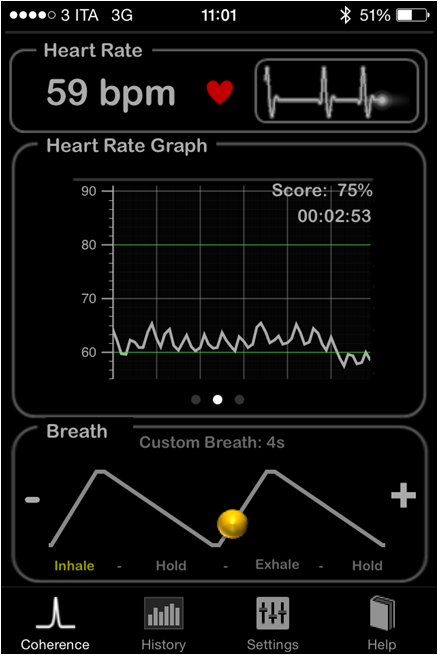
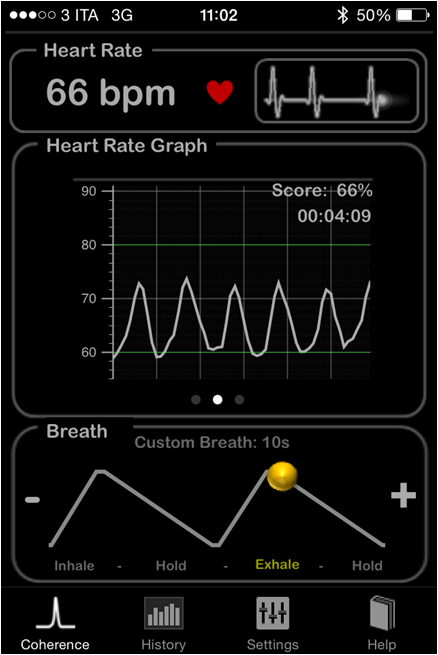
Are you interested in knowing about scientific evidences of the advantages of the resonant breathing?
Read Here
- Kleiger RE, Miller JP, Bigger JT Jr, Moss AJ. (1987). "Decreased heart rate variability and its association with increased mortality after acute myocardial infarction". Am J Cardiol. 59 (4): 256–262. doi:10.1016/0002-9149(87)90795-8. PMID 3812275.
- Abildstrom SZ, Jensen BT, Agner E et al. (2003). "Heart rate versus heart rate variability in risk prediction after myocardial infarction". Journal of Cardiovascular Electrophysiology 14 (2): 168–73. doi:10.1046/j.1540-8167.2003.02367.x. PMID 12693499.
- Zhang J.” Effect of age and sex on heart rate variability in healthy subjects” J Manipulative Physiol Ther. 2007 Jun;30(5):374-9.